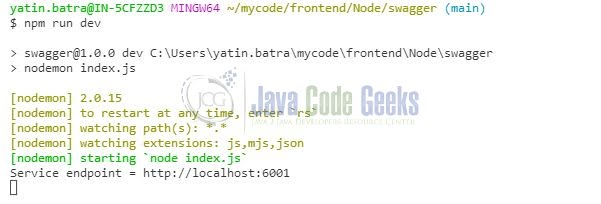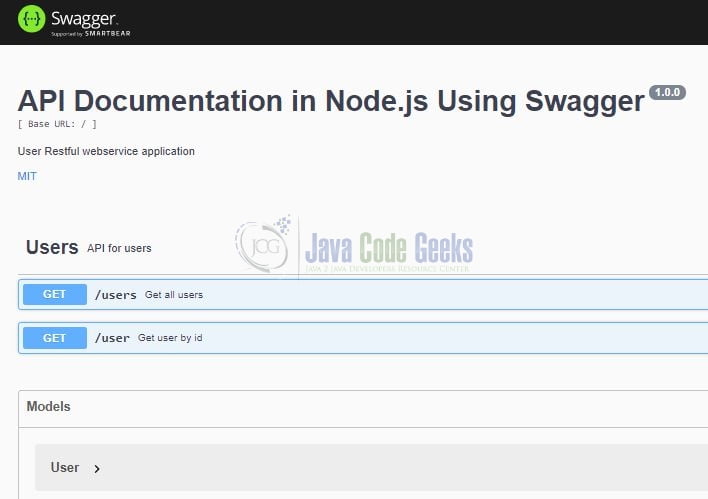API Documentation in Node.js Using Swagger
Hello. In this tutorial, we will understand how to write API documentation in Node.js using Swagger.
1. Introduction
A swagger is a popular tool used for generating interactive API documentation. In this tutorial, we will see how to write swagger api documentation in the nodejs application.
1.1 Setting up Node.js
To set up Node.js on windows you will need to download the installer from this link. Click on the installer (also include the NPM package manager) for your platform and run the installer to start with the Node.js setup wizard. Follow the wizard steps and click on Finish when it is done. If everything goes well you can navigate to the command prompt to verify if the installation was successful as shown in Fig. 1.
2. API Documentation in Node.js Using Swagger
To set up the application, we will need to navigate to a path where our project will reside. For programming stuff, I am using Visual Studio Code as my preferred IDE. You’re free to choose the IDE of your choice.
2.1 Setting up the implementation
Let us write the different files which will be required for practical learning.
2.1.1 Setting up dependencies
Navigate to the project directory and run npm init -y to create a package.json file. This file holds the metadata relevant to the project and is used for managing the project dependencies, script, version, etc. Add the following code to the file wherein we will specify the required dependencies.
package.json
{
"name": "swagger",
"version": "1.0.0",
"description": "api documentation via swagger in nodejs application",
"main": "index.js",
"scripts": {
"dev": "nodemon index.js",
"test": "echo \"Error: no test specified\" && exit 1"
},
"keywords": [
"nodejs",
"expressjs",
"apidocumentation",
"swagger"
],
"author": "javacodegeeks",
"license": "MIT",
"dependencies": {
"express": "^4.17.1",
"swagger-ui-express": "^4.2.0"
},
"devDependencies": {
"nodemon": "^2.0.15"
}
}
To download the dependencies navigate to the directory path containing the file and use the npm install command. If everything goes well the dependencies will be loaded inside the node_modules folder and you are good to go with the further steps.
2.1.2 Creating swagger.json file
Creating a swagger.json file in the project’s root directory that will be responsible to create the description of the entire api. For this tutorial, we will be exposing two points and the entity/dto object which will be used in response for the client.
- Get all users
- Get user by id
swagger.json
{
"swagger": "2.0",
"info": {
"version": "1.0.0",
"title": "API Documentation in Node.js Using Swagger",
"description": "User Restful webservice application",
"license": {
"name": "MIT",
"url": "https://opensource.org/licenses/MIT"
}
},
"basePath": "/",
"tags": [
{
"name": "Users",
"description": "API for users"
}
],
"produces": ["application/json"],
"paths": {
"/users": {
"get": {
"tags": ["Users"],
"summary": "Get all users",
"responses": {
"200": {
"description": "ok",
"schema": {
"$ref": "#/definitions/Users"
}
}
}
}
},
"/user": {
"parameters": [
{
"name": "id",
"in": "query",
"required": true,
"description": "Id of the user which is to be searched",
"type": "integer"
}
],
"produces": ["application/json"],
"get": {
"tags": ["Users"],
"summary": "Get user by id",
"responses": {
"200": {
"description": "ok",
"schema": {
"$ref": "#/definitions/User"
}
},
"404": {
"description": "not found"
}
}
}
}
},
"definitions": {
"User": {
"required": ["name", "_id", "companies"],
"properties": {
"id": {
"type": "integer",
"uniqueItems": true
},
"name": {
"type": "string"
},
"username": {
"type": "string"
},
"email": {
"type": "string"
},
"address": {
"type": "object",
"properties": {
"street": {
"type": "string"
},
"suite": {
"type": "string"
},
"city": {
"type": "string"
},
"zipcode": {
"type": "string"
}
}
},
"phone": {
"type": "string"
},
"website": {
"type": "string"
},
"company": {
"type": "object",
"properties": {
"name": {
"type": "string"
},
"catchPhrase": {
"type": "string"
},
"bs": {
"type": "string"
}
}
}
}
},
"Users": {
"type": "array",
"$ref": "#/definitions/User"
}
}
}
2.1.3 Creating a service class
Create a service file in the service folder which will be responsible to send the response to the user for the get all users endpoint and get user by id endpoint. Here we are sending the mock data but in an ideal application, this data would be fetched from the database.
user.js
const getUsers = () => {
return [
{
id: 1,
name: "Leanne Graham",
username: "Bret",
email: "Sincere@april.biz",
address: {
street: "Kulas Light",
suite: "Apt. 556",
city: "Gwenborough",
zipcode: "92998-3874"
},
phone: "1-770-736-8031 x56442",
website: "hildegard.org",
company: {
name: "Romaguera-Crona",
catchPhrase: "Multi-layered client-server neural-net",
bs: "harness real-time e-markets"
}
},
{
id: 2,
name: "Ervin Howell",
username: "Antonette",
email: "Shanna@melissa.tv",
address: {
street: "Victor Plains",
suite: "Suite 879",
city: "Wisokyburgh",
zipcode: "90566-7771"
},
phone: "010-692-6593 x09125",
website: "anastasia.net",
company: {
name: "Deckow-Crist",
catchPhrase: "Proactive didactic contingency",
bs: "synergize scalable supply-chains"
}
},
{
id: 3,
name: "Clementine Bauch",
username: "Samantha",
email: "Nathan@yesenia.net",
address: {
street: "Douglas Extension",
suite: "Suite 847",
city: "McKenziehaven",
zipcode: "59590-4157"
},
phone: "1-463-123-4447",
website: "ramiro.info",
company: {
name: "Romaguera-Jacobson",
catchPhrase: "Face to face bifurcated interface",
bs: "e-enable strategic applications"
}
},
{
id: 4,
name: "Patricia Lebsack",
username: "Karianne",
email: "Julianne.OConner@kory.org",
address: {
street: "Hoeger Mall",
suite: "Apt. 692",
city: "South Elvis",
zipcode: "53919-4257"
},
phone: "493-170-9623 x156",
website: "kale.biz",
company: {
name: "Robel-Corkery",
catchPhrase: "Multi-tiered zero tolerance productivity",
bs: "transition cutting-edge web services"
}
},
{
id: 5,
name: "Chelsey Dietrich",
username: "Kamren",
email: "Lucio_Hettinger@annie.ca",
address: {
street: "Skiles Walks",
suite: "Suite 351",
city: "Roscoeview",
zipcode: "33263"
},
phone: "(254)954-1289",
website: "demarco.info",
company: {
name: "Keebler LLC",
catchPhrase: "User-centric fault-tolerant solution",
bs: "revolutionize end-to-end systems"
}
}
];
};
const getUserById = (key) => {
console.log("Search key = " + key);
const item = getUsers().filter((user) => {
if (user.id == key) {
return user;
}
});
if (item.length > 0) {
console.log("User found!");
return item;
} else {
return false;
}
};
module.exports = {
getUsers,
getUserById
};
2.1.4 Creating the index file
Create the file that will act as a welcome point for the application. The file will be responsible to handle the incoming request from the client and initialize the swagger configuration. During the swagger configuration initialization, it will parse the swagger.json file and will expose an api-docs endpoint.
user.js
// application
const express = require("express");
const app = express();
app.use(express.json());
const { getUsers, getUserById } = require("./service/user");
// swagger config
const swaggerUi = require("swagger-ui-express"),
swaggerDoc = require("./swagger.json");
// application routes
// get all users
// endpoint = http://localhost:6001/users
app.get("/users", (req, res) => {
return res.status(200).json({
status: "ok",
item: getUsers()
});
});
// get user by id
// endpoint = http://localhost:6001/user?id=1
app.get("/user", (req, res) => {
let id = req.query.id;
const user = getUserById(id);
if (!user) {
return res.status(404).json({
status: "not found",
message: "resource not found"
});
} else {
return res.status(200).json({
status: "ok",
item: user
});
}
});
// setting up swagger
// endpoint = http://localhost:6001/api-docs/
app.use("/api-docs", swaggerUi.serve, swaggerUi.setup(swaggerDoc));
// start application
const port = process.env.PORT || 6001;
app.listen(port, () => {
console.log(`Service endpoint = http://localhost:${port}`);
});
3. Run the Application
To run the application navigate to the project directory and enter the following command as shown below.
Command
$ nodemon
If everything goes well the application will be started successfully on port – 6001 as shown in Fig. 2.
4. Demo
Open up the browser and hit the endpoints to confirm that the application is running fine. But in this tutorial, we have an extra thing wherein one can also check the swagger documentation generated at the below link –
Swagger endpoint
http://localhost:6001/api-docs/
If everything goes the swagger documentation will be generated as shown in Fig. 3.
That is all for this tutorial and I hope the article served you with whatever you were looking for. Happy Learning and do not forget to share!
5. Summary
In this tutorial, we saw how to set up swagger documentation in a nodejs application for the api. You can download the source code and the postman collection from the Downloads section.
6. Download the Project
This was a tutorial to set up swagger documentation in a nodejs application for the api.
You can download the full source code of this example here: API Documentation in Node.js Using Swagger






So I was working with vanilla Nodejs and swagger and is it possible to implement swagger with Vanilla nodejs